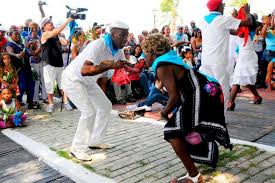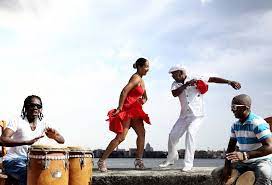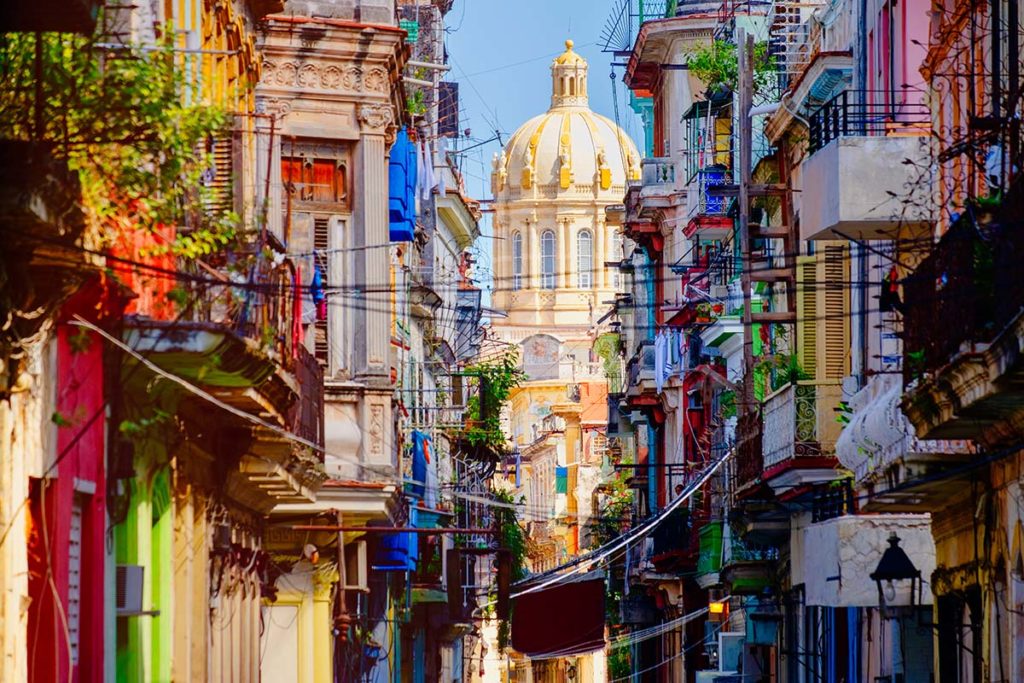LA GUARACHA Y LA RUMBA, SUS SIGNIFICADOS SON EL “HOLGORIO” Y LA “FIESTA” CUBANA. PHOTOS.
La palabra rumba es un término abstracto que ha sido aplicado con diferentes propósitos a una amplia variedad de temas durante largo tiempo. Desde un punto de vista semántico el término rumba puede ser incluido en un grupo de palabras con similar significado tales como conga, milonga, bomba, tumba, samba, bamba, mambo, tambo, tango, cumbé, cumbia y candombe. Todas ellas denotan un origen congolés debido a la utilización de combinaciones de sonidos tales como mb, ng y nd, que son típicos del complejo lingüístico Níger-Congo.
Quizás el más antiguo y general de sus significados es el de “fiesta” u “holgorio”. Ya durante la segunda mitad del siglo xix podemos encontrar esta palabra utilizada varias veces con el propósito de representar una fiesta en un cuento corto llamado “La mulata de rumbo”, del folklorista cubano Francisco de Paula Gelabert: “…más gozo yo y me divierto en una rumbita con las de mi color y de mi clase…”, o “Leocadia iba a acostarse, como había dicho, nada menos que a las doce del día, cuando llegó a la casa uno de sus amigos de rumbas, acompañado de otro joven que iba a presentarle…”.
Según Alejo Carpentier “…es significativo el hecho de que la palabra rumba haya pasado al lenguaje del cubano como sinónimo de holgorio, baile licencioso, juerga con mujeres del rumbo.”
Como ejemplo pudiéramos mencionar las fiestas de Yuka y Makuta, y los changüises en Cuba, así como la milonga y el tango en Argentina, donde la palabra rumba fue originalmente utilizada para denominar una reunión festiva; y con el trascurso del tiempo se usó para nombrar los géneros de música y danza correspondientes a estas festividades.
Algunos académicos han señalado que en cuanto a la utilización de los términos rumba y guaracha, nos encontramos ante un caso de sinonimia, es decir, del uso de dos palabras diferentes para nombrar una misma cosa. En el siguiente comentario de María Teresa Linares se pone en evidencia la imprecisión de los términos rumba y guaracha en cuanto al propósito de definir un género musical específico, cuando nos dice que: “…en los primeros años de este siglo [XX], se mantenían al final de las obras del teatro vernáculo, unos fragmentos musicales que cantaban los propios autores y que se les llamó rumba final…” y continúa explicando que estas… “eran ciertamente guarachas.”
A lo que se pudiera añadir que a las piezas musicales que cerraban las obras se les podía haber llamado indistintamente rumbas o guarachas, ya que estos términos no indicaban ninguna diferencia genérica o estructural entre ellas. Linares también dice en referencia a este tema: “Se conservan grabaciones de los artistas del Teatro Alhambra de guarachas y rumbas que no se diferenciaban entre sí en el acompañamiento de las guitarras –cuando se trataba de un pequeño grupo, dúo o trío- o por la orquesta del teatro o piano. Las etiquetas de los discos decían: diálogo y rumba”.
LA RUMBA URBANA Y LOS RUMBEROS..
La Rumba Urbana (también llamada Rumba de Solar o de Cajón), es una amalgama de varias tradiciones musicales y danzarias africanas, combinadas con influencias hispanas. De acuerdo con el musicólogo cubano Argeliers León: “En la fiesta que constituyó una rumba concurrieron, pues, determinados aportes afroides, pero convergieron también otros elementos, de raíz hispánica, que habían sido incorporados ya a las expresiones que aparecían en la nueva población que surgía en la Isla.
La Rumba de Cajón es un estilo de música seglar que surge en los muelles y las áreas menos prósperas de la Habana y Matanzas. En sus comienzos, los ejecutantes de la Rumba utilizaron un trío de cajones de madera para tocar, los cuales fueron sustituidos más tarde por tambores, similares en su apariencia a las congas o tumbadoras. El tambor más agudo es llamado “quinto”, el de tesitura media “macho” o “tres-dos”, debido a que su ritmo esencial está basado en el patrón de la clave cubana, y el más grave es llamado “hembra o salidor”, porque usualmente comenzaba o “rompía” la Rumba.
En el conjunto instrumental de la Rumba también se utilizan dos palillos para golpear una pieza hueca de bambú llamada “guagua” o “catá”, así como las Claves Cubanas, el Güiro y unas sonajas de origen bantú llamadas “nkembi”.
La parte vocal de la Rumba corresponde a una versión modificada del antiguo estilo español de “copla y estribillo”, incluyendo una sección llamada “montuno” que pudiera ser considerada como un estribillo ampliado o desarrollado, el cual constituye una sección independiente donde se utiliza frecuentemente el conocido estilo de “pregunta y respuesta”, tan característico de las tradiciones musicales africanas.
De los múltiples estilos que comenzaron a aparecer a fines del siglo xix, llamados del “Tiempo’España”, tales como la tahona, la jiribilla, el palatino, y la resedá, solo tres formas de Rumba han sobrevivido: la columbia, el guaguancó, y el yambú. La columbia, ejecutada en 6/8, es comúnmente una danza interpretada por un solista masculino. Esta es rápida y ágil, e incluye movimientos agresivos y acrobáticos. El guagancó es bailado por un hombre y una mujer, y simula la persecución sexual del macho a la hembra. El yambú, que es acutualmente una reliquia, representa la burlesca imitación de un par de ancianos que danzan lentamente. Todas las formas de Rumba son acompañadas por cantos apoyados por el conjunto de percusión.
La Rumba de Solar o de Cajón es hoy día un género fósil que puede ser visto en Cuba en las presentaciones de grupos profesionales que se dedican al cultivo de este género. También existen grupos de aficionados radicados en las llamadas “Casas de Cultura”, y en centros de trabajo. Como todos los aspectos de la sociedad en Cuba, las actividades musicales y danzarias son organizadas por el estado a través de Ministerios y otros organismos.
LA GUARACHA CUBANA…
La Guaracha Cubana, que disfrutaba de gran popularidad en La Habana, comenzaron a penetrar las áreas rurales en una época indeterminada durante el siglo xix. Este proceso no es difícil de imaginar si consideramos cuan cercanas se encontraban las áreas rurales de las urbanas en Cuba, en aquella época.
Esa es la razón por la cual los campesinos cubanos (llamados guajiros) comenzaron a incluir en sus fiestas (llamadas “guateques” o “changüís”, así como en celebraciones como las “fiestas patronales” y las “parrandas”, unas Rumbitas que eran muy parecidas a las Guarachas urbanas, cuyo metro binario contrastaba con el característico metro ternario de sus tradicionales “tonadas” y “zapateos”.
Esas Rumbitas rurales han sido llamadas por el reconocido musicólogo Danilo Orozco proto-sones”, “soncitos primigenios”, “rumbitas”, “nengones” o “marchitas,” y algunas de ellas como la Caringa, el Papalote, Doña Joaquina, Anda Pepe y el Tingotalango han sido preservadas hasta el tiempo presente.
Las Rumbitas rurales mostraban un mayor número de características de la música africana en comparación con la Guaracha habanera, debido a la integración gradual de ciudadanos afro-cubanos al ambiente rural.
Una de las más evidentes características de las Rumbitas Rurales fue su propia forma, muy similar a las típicas estructuras vocales africanas. En este caso, toda la canción estaba basada en un solo fragmento musical o frase de corta duración que era repetida, con algunas variaciones, una y otra vez; alternando frecuentemente con un coro. Este estilo fue llamado “Montuno” (literalmente del “monte” o “del campo”) debido a su origen rural.
Otra característica de este nuevo género era la superposición de diferentes patrones rítmicos ejecutados simultáneamente, de manera similar a la utilizada en la Rumba Urbana, lo cual es también un rasgo distintivo de la tradición musical africana.
THE GUARACHA AND THE RUMBA, THEIR MEANINGS ARE THE “HOLGORIO” AND THE CUBAN “FIESTA”. PHOTOS
The word rumba is an abstract term that has been applied for different purposes to a wide variety of topics for a long time. From a semantic point of view, the term rumba can be included in a group of words with a similar meaning such as conga, milonga, bomba, tumba, samba, bamba, mambo, tambo, tango, cumbé, cumbia and candombe. a Congolese origin due to the use of sound combinations such as mb, ng and nd, which are typical of the Niger-Congo language complex.
Perhaps the oldest and most general of its meanings is that of “party” or “holiday”. Already during the second half of the 19th century we can find this word used several times with the purpose of representing a party in a short story called “La mulata de rumbo”, by the Cuban folklorist Francisco de Paula Gelabert: “…I enjoy more and I have fun in a party with those of my color and class…”, or “Leocadia was going to bed, as she had said, at no less than twelve o’clock, when one of her partying friends arrived at the house, accompanied by another young man who was going to introduce him…”.
According to Alejo Carpentier “…it is significant that the word rumba has passed into the Cuban language as a synonym for feasting, licentious dancing, partying with women from the area.”
As an example we could mention the Yuka and Makuta parties, and the changüises in Cuba, as well as the milonga and tango in Argentina, where the word rumba was originally used to denote a festive gathering; and over time it was used to name the genres of music and dance corresponding to these festivities.
Some academics have pointed out that in terms of the use of the terms rumba and guaracha, we are faced with a case of synonymy, that is, the use of two different words to name the same thing. The following comment by María Teresa Linares highlights the imprecision of the terms rumba and guaracha in terms of the purpose of defining a specific musical genre, when she tells us that: “…in the early years of this [20th] century, they kept at the end of the vernacular theater works, some musical fragments that the authors themselves sang and that were called final rumba…” and he goes on to explain that these… “were certainly guarachas.”
One could add that the musical pieces that closed the works could have been called rumbas or guarachas indistinctly, since these terms did not indicate any generic or structural difference between them. Linares also says in reference to this subject: “Recordings of the artists of the Alhambra Theater of guarachas and rumbas that did not differ from each other in the accompaniment of the guitars -when it was a small group, duo or trio- or by the theater orchestra or piano. The labels of the discs said: dialogue and rumba”.
THE URBAN RUMBA AND THE RUMBEROS..
Urban Rumba (also called Solar Rumba or Cajon Rumba) is an amalgamation of various African musical and dance traditions, combined with Hispanic influences. According to the Cuban musicologist Argeliers León: “In the party that constituted a rumba, certain Afroid contributions attended, but other elements also converged, with Hispanic roots, which had already been incorporated into the expressions that appeared in the new population that arose on the Island.
La Rumba de Cajón is a secular style of music that emerges in the docks and less prosperous areas of Havana and Matanzas. In its early days, Rumba players used a trio of wooden cajons to play, which were later replaced by drums, similar in appearance to congas or tumbadoras. The highest pitched drum is called “quinto”, the one with medium pitch “macho” or “three-two”, because its essential rhythm is based on the pattern of the Cuban clave, and the lowest one is called “female or salidor”. ”, because he usually started or “broke” the Rumba.
In the Rumba instrumental group, two sticks are also used to hit a hollow piece of bamboo called “guagua” or “catá”, as well as the Cuban Claves, the Güiro, and rattles of Bantu origin called “nkembi”.
The vocal part of the Rumba corresponds to a modified version of the old Spanish style of “copla y estribillo”, including a section called “montuno” that could be considered as an expanded or developed chorus, which constitutes an independent section where it is frequently used. the well-known “question and answer” style, so characteristic of African musical traditions.
Of the multiple styles that began to appear at the end of the 19th century, called “Tiempo’España”, such as the tahona, the jiribilla, the palatino, and the resedá, only three forms of Rumba have survived: the Columbia, the guaguancó , and the yambú. The columbia, performed in 6/8 time, is commonly a dance performed by a male soloist. This one is fast and agile, and includes aggressive and acrobatic moves. The guagancó is danced by a man and a woman, and simulates the male’s sexual persecution of the female. The yambú, which is now a relic, represents the burlesque imitation of a pair of old men who dance slowly. All forms of Rumba are accompanied by singing supported by the percussion ensemble.
The Rumba de Solar or de Cajón is today a fossil genre that can be seen in Cuba in the presentations of professional groups that are dedicated to the cultivation of this genre. There are also groups of fans based in the so-called “Houses of Culture” and in workplaces. Like all aspects of society in Cuba, musical and dance activities are organized by the state through Ministries and other bodies.
THE CUBAN GUARACHA…
The Cuban Guaracha, which enjoyed great popularity in Havana, began to penetrate rural areas at an indeterminate time during the 19th century. This process is not difficult to imagine if we consider how close the rural areas were to the urban ones in Cuba at that time.
That is the reason why Cuban peasants (called guajiros) began to include in their festivals (called “guateques” or “changüís”, as well as in celebrations such as “patron saint festivities” and “parrandas”), some Rumbitas that were very similar to the urban Guarachas, whose binary meter contrasted with the characteristic ternary meter of their traditional “tonadas” and “zapateos”.
These rural Rumbitas have been called by the renowned musicologist Danilo Orozco proto-sones”, “primigenial soncitos”, “rumbitas”, “nengones” or “marches,” and some of them like the Caring, the Papalote, Doña Joaquina, Anda Pepe and the Tingotalango have been preserved to the present time.
The rural Rumbitas showed a greater number of characteristics of African music compared to the Guaracha habanera, due to the gradual integration of Afro-Cuban citizens into the rural environment.
One of the most evident characteristics of the Rural Rumbitas was their own shape, very similar to typical African vocal structures. In this case, the entire song was based on a single musical fragment or phrase of short duration that was repeated, with some variations, over and over again; frequently alternating with a choir. This style was called “Montuno” (literally from the “mountain” or “from the field”) due to its rural origin.
Another characteristic of this new genre was the overlapping of different rhythmic patterns performed simultaneously, similar to that used in Urban Rumba, which is also a distinctive feature of the African musical tradition.
Agencies/ Wiki/ MusicaCubanaHist./ Extractos/ Excerpts/ Internet Photos/ Arnoldo Varona/ www.TheCubanHistory.com
THE CUBAN HISTORY, HOLLLYWOOD.











